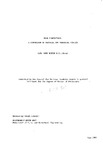WAVE OVERTOPPING: A COMPARISON OF PHYSICAL AND NUMERICAL STUDIES
| dc.contributor.author | Murton, Gary John | |
| dc.contributor.other | School of Engineering, Computing and Mathematics | en_US |
| dc.date.accessioned | 2013-10-25T08:31:01Z | |
| dc.date.available | 2013-10-25T08:31:01Z | |
| dc.date.issued | 1991 | |
| dc.identifier | NOT AVAILABLE | en_US |
| dc.identifier.uri | http://hdl.handle.net/10026.1/2361 | |
| dc.description | Merged with duplicate record 10026.1/678 on 07.03.2017 by CS (TIS) | |
| dc.description.abstract |
The overtopping of low-crested breakwater is investigated by means of hydraulic and mathematical models. A conventional laboratory wavemaker with a wedge-type paddle is converted into an absorbing wavemaker so that it can be used to investigate accurately wave overtopping of reflective coastal structures. The absorption system is achieved by use of a feedback loop added to the control circuit. The design criteria and implementation of the circuit are presented in detail. Enhanced control software is used to generate different 'random' sea states with the same statistical properties. The absorption system is validated by ail extensive series of tests made possible by the development of automated data acquisition and analysis software. Particular attention is given to the derivation of incident and reflected wave spectra. The results show over 90% success in reducing reflected waves. It is also possible to establish stable standing wave patterns over a wide frequency range. The results show significant improvement over similar existing wavemakers and in effect create an open-ended channel in the sense that the test structure hardly influences incident wave conditions. A closely controlled series of overtopping tests was carried out using the absorption system to prevent any re-reflections. Equipment and software were designed to quantify the overtopping rates for the structures used. The design and implementation of all aspects of the tests is fully described. Overlapping tests were carried out on breakwaters with smooth l:l and 1:2 seaward slopes. The results are tabulated and plotted in a dimension less form which permits comparison with earlier work carried out at Hydraulics Research Ltd. The range of available data is extended and the new data for fully-developed sea states shown to be compatible with a linear extrapolation of the earlier results. It is believed that the earlier results were obtained using fully developed sea states but this is not known for certain. The importance of rigorously defining and publishing both test conditions and analysis techniques is highlighted. In the numerical study the 1-D mass and continuity equations were solved by a hybrid finite element/finite difference scheme. Whilst a good comparison is achieved between the physical and numerical tests for breakwater slopes of 1:2 and less, realistic results are not achieved for steeper slopes. The reasons for this are discussed and the results presented. Both sets of model tests add valuable data to an area presently lacking detailed information. | en_US |
| dc.language.iso | en | en_US |
| dc.publisher | University of Plymouth | en_US |
| dc.title | WAVE OVERTOPPING: A COMPARISON OF PHYSICAL AND NUMERICAL STUDIES | en_US |
| dc.type | Thesis | |
| dc.identifier.doi | http://dx.doi.org/10.24382/1534 | |
| dc.identifier.doi | http://dx.doi.org/10.24382/1534 |
Files in this item
This item appears in the following Collection(s)
-
01 Research Theses Main Collection
Research Theses Main


